Let’s learn about the sharp sign. This is the actual symbol: ♯. However in type, it is often written like this: # (same symbol as pound, number sign or hash symbol on social media.)
The main difference between the actual sharp sign and the pound (number) or hash sign is that the number/hashtag sign has two horizontal strokes while the sharp musical sign has two slanted parallel lines which rise from left to right, in order to avoid being obscured by the horizontal musical staff lines.
Highly Recommended: Click here for one of the BEST piano/keyboard courses I’ve seen online.
A sharp symbol, when placed in front a note, increases its pitch by a half step or semitone. For instance, C♯ is a half step higher than C, and D♯ is a half step higher than D.
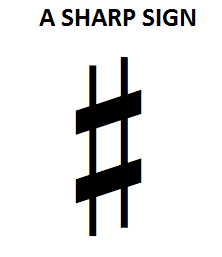 On piano, the black keys are usually referred to as sharp or flat keys. For example, the key to the immediate right of C is C♯, the key to the immediate right of D is D♯ and the key to the immediate right of F is F♯. As we mentioned earlier, they are a half step higher than the keys to their left.
On piano, the black keys are usually referred to as sharp or flat keys. For example, the key to the immediate right of C is C♯, the key to the immediate right of D is D♯ and the key to the immediate right of F is F♯. As we mentioned earlier, they are a half step higher than the keys to their left.
Since they are a half step lower than the keys to their right they can also be called flats. Flat symbol: ♭. The term for this is enharmonics. Enharmonics are notes that are the same pitch but are known by two different names, for instance C-sharp and D-flat. So, C sharp is an enharmonic of D flat. But on piano, they make use of the same key. The same key is labeled C sharp and D flat, the same key is labeled A flat and G flat, and so on. (But for the purpose of this lesson our main focus is sharps.) 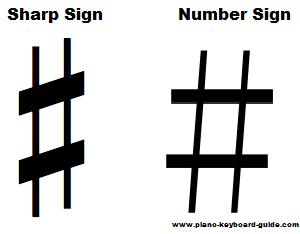
While the black keys are called sharp or flat keys, the white ones are called natural keys.
In terms of sharp and natural keys, the 12 keys on piano starting from C are C, C♯, D, D♯, E, F, F♯, G, G♯, A, A♯, and B. C, D, E, F, G, A and B are the natural keys, while C♯, D♯, F♯, G♯ and A♯ are obviously, the sharps.
Here’s a diagram showing sharps and natural keys on your piano: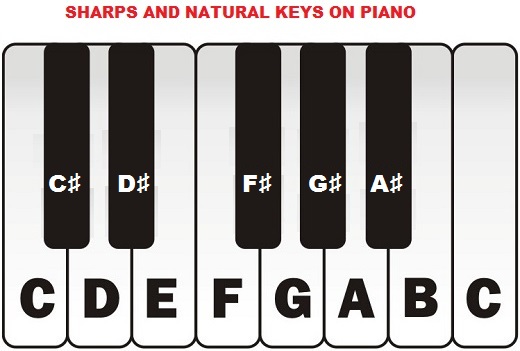
In fact, the sharp symbol before a note in a musical piece simply means to play the next key to the right, whether it’s a black key or a white key. When a sharp (♯) symbol appears before a note, it applies to that note for the rest of the measure. Once the measure ends, the sharp is no longer in effect. To cancel out sharp in a measure, a natural sign is used.
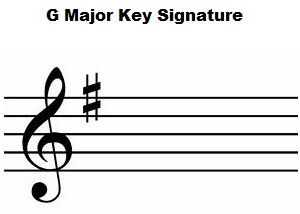 Sometimes, the sharp symbol is stated in the key signature. One example is the G key signature. This is because there is one sharp in the G major scale called F#. (The G major scale’s pitches are G-A-B-C-D-E-F#.) That way there is no need to place a sharp before each and every F note. Every time you see an F, for the entire piece, it’s actually F sharp that must be played on your piano. If a sharp (or flat) sign is not stated in the key signature but only on a certain place in a musical piece, it is called an accidental.
Sometimes, the sharp symbol is stated in the key signature. One example is the G key signature. This is because there is one sharp in the G major scale called F#. (The G major scale’s pitches are G-A-B-C-D-E-F#.) That way there is no need to place a sharp before each and every F note. Every time you see an F, for the entire piece, it’s actually F sharp that must be played on your piano. If a sharp (or flat) sign is not stated in the key signature but only on a certain place in a musical piece, it is called an accidental.
Having said all of this, I have to make one thing clear. This is the fact that sharps and flats are not black keys. All black keys are either sharp or flat but not all sharps and flats are black keys. White keys can be sharp or flat too. For example, on a piece of music, if you see a sharp on the note E, it means to play the note to the right of E on your piano. It means to play the key that is a semitone higher. This is actually, the note E#, although it is normally labeled as F on your piano and is the same key. E# and F are enharmonics. For a better understanding of this read the difference between notes and keys on the piano.
To draw a sharp sign, slant the horizontal lines of the sign upwards and to the right. The space in the middle of the sharp sign is placed on the same staff line or space as the notehead that follows it. The height of the sharp sign is about three staff spaces.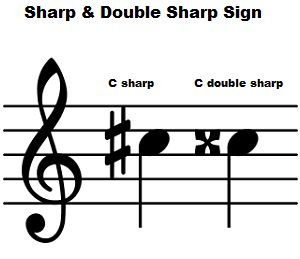
Double Sharp Sign
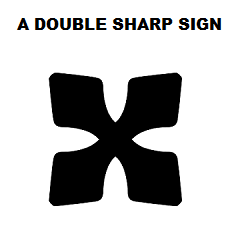 Another musical symbol is the double sharp. A double-sharp is the equivalent of two sharps, and raises a note’s pitch by two semitones (a whole tone). This symbol is similar to a bold x, and is placed before a note like other accidentals. Its height is one staff space, and it is centered on the same line or space as the notehead that it alters. A double sharp simply means to play the note that is two semitones higher. So for instance, if you see this symbol before the note C on a musical piece, you would have to play D on your piano. As a beginner, you don’t have to bother with this too much as yet. This sign is not as common as regular sharps and flats.
Another musical symbol is the double sharp. A double-sharp is the equivalent of two sharps, and raises a note’s pitch by two semitones (a whole tone). This symbol is similar to a bold x, and is placed before a note like other accidentals. Its height is one staff space, and it is centered on the same line or space as the notehead that it alters. A double sharp simply means to play the note that is two semitones higher. So for instance, if you see this symbol before the note C on a musical piece, you would have to play D on your piano. As a beginner, you don’t have to bother with this too much as yet. This sign is not as common as regular sharps and flats.
Learn to play piano: read about the sharp sign, flat sign, half steps and whole steps here.
I highly recommend Piano For All to piano students. Click here to learn all about the Piano For All piano lessons.